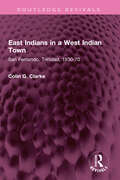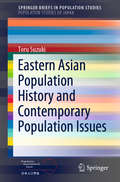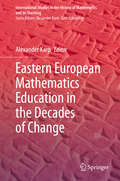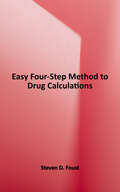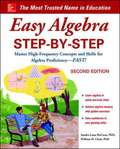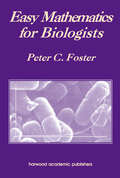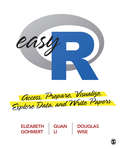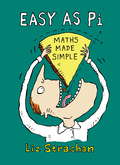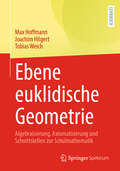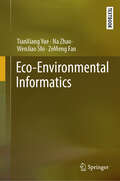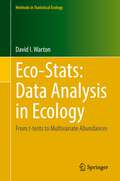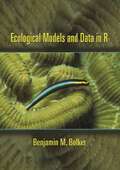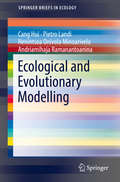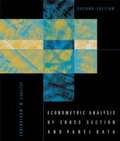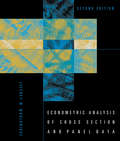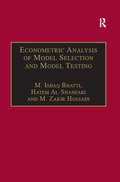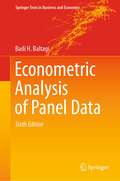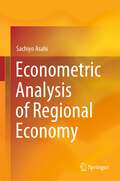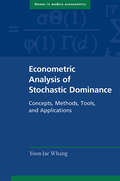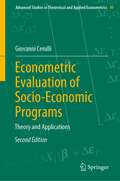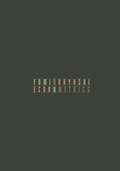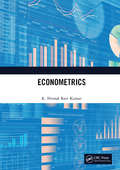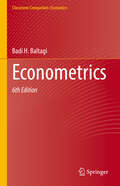- Table View
- List View
East Indians in a West Indian Town: San Fernando, Trinidad, 1930-70 (Routledge Revivals)
by Colin G ClarkeFirst published in 1986, East Indians in a West Indian Town explores the complex geographical, sociological and anthropological dimensions of Trinidad society before and after its political independence, by employing three sets of materials – census data, questionnaires and participant-observation records. Cartographic, humanistic and statistical approaches are combined in a historical perspective to deal with the significance of race, cultural distinctions and class in San Fernando. A major concern of the book is to examine the social complexity that lies behind geographical patterns, and to compare aggregate data with group behaviour. This book will be of interest to students of geography, sociology and anthropology.
Eastern Asian Population History and Contemporary Population Issues (SpringerBriefs in Population Studies)
by Toru SuzukiThis book interprets and explains contemporary population issues from historical and cultural perspectives. These include lowest-low fertility in the Republic of Korea and Taiwan, early population aging in China relative to the developmental level, and various modes of domestic and international migration in the region. The book shows that divergent fertility decline can be attributed to the family patterns established in the pre-modern era in each country. It also examines the diversity of international migration in Eastern Asian countries today is also understood from the long-term historical view.
Eastern European Mathematics Education in the Decades of Change (International Studies in the History of Mathematics and its Teaching)
by Alexander KarpThis contributed volume is devoted to the recent history and evolution of mathematics education in Eastern Europe, exploring how it was influenced by social and political changes in this part of the world. Despite the broad recognition of the importance of these changes, little scholarship exists that examines the ways in which they were followed by changes in the teaching of mathematics in the post-socialist countries. Indeed, the analyzed processes are complex and vary across the states. Accordingly, this book touches on many factors--including differences in cultures and traditions – that find expression in the teaching of mathematics. Specifically, this volume seeks to explore what changes there were in education in general and in the position of mathematics in school education in these years, and how these changes may be explained and documented; what changes there were in the content of mathematics education and its assessment, and how were they motivated and adopted; what new textbooks appeared and what new methodological ideas were offered in them; how and why mathematics teacher education and/or professional development changed; what was the role (if any) of foreign influences on mathematics education, etc.The book will be of interest to both researchers in mathematics education and practitioners-teachers, as well as a broader audience of historians and educators exploring the political aspects of education.
Easy 4-Step Method to Drug Calculations
by S. D. FoustThis unique work-text has been class-tested by hundreds of students. It makes the difficult concept of drug dosage calculations easy to understand and master by using a simple four-step method that focuses only on the information necessary for learning this skill. The readers are guided through every step of the calculation process with easy-to-understand and follow explanations. This is the perfect resource for paramedics, nurses, students and any other health care professionals who administer medication. Features Include: *Straightforward and easy to read *Hundreds of practice problems that incorporate realistic patient scenarios, protocols, and the latest trends in treatment management. *Final review section *Worked out-answer section clearly shows students every step of the problem-solving process.
Easy Algebra Step-by-Step: Master High-Frequency Concepts and Skills for Algebra Proficiency--FAST!
by Sandra Luna McCune William D. ClarkEasy Algebra Step-by-Step is an interactive approach to learning basic algebra. It contains completely worked-out sample solutions that are explained in detailed, step-by-step instructions. Moreover, it features guiding principles, cautions against common errors, and offers other helpful advice as "pop-ups" in the margins. The book takes you from number concepts to skills in algebraic manipulation and ends with word problems. Concepts are broken into basic components to provide ample practice of fundamental skills. The anxiety you may feel while trying to succeed in algebra is a real-life phenomenon. Many people experience such a high level of tension when faced with an algebra problem that they simply cannot perform to the best of their abilities. It is possible to overcome this difficulty by building your confidence in your ability to do algebra and by minimizing your fear of making mistakes.
Easy Mathematics for Biologists
by Peter C. FosterBecause elementary mathematics is vital to be able to properly design biological experiments and interpret their results. As a student of the life sciences you will only make your life harder by ignoring mathematics entirely. Equally, you do not want to spend your time struggling with complex mathematics that you will never use. This book is the pe
Easy R: Access, Prepare, Visualize, Explore Data, and Write Papers
by Elizabeth A. Gohmert Quan L. Li Douglas R. WiseDo you want to learn R? This book is built on the premise that anyone with a bit of free time and a healthy curiosity can learn to use R in their studies or at work. The authors focus on using R to do useful things like writing reports, creating data and graphs, accessing datasets collected by others, preparing data, and conducting simple data analysis. In this book you’ll learn how to: install R and RStudio®, and set up an RStudio® project and folders; write an essay with graphs based on simple real-world data using R Markdown; create variables from everyday numeric information and visualize data through five types of charts—bar plot, histogram, pie chart, scatter plot, and time series line plot—to identify patterns in the data; write and run R programs, and prepare your data following the tidyverse approach; import external datasets into R, install R data packages, and carry out initial data validity checks; conduct exploratory data analysis through three exercises involving data on voting outcomes, natural resource consumption, and gross domestic product (GDP) via data visualization, correlation coefficient, and simple regression; and write a research paper on the impact of GDP per capita on life expectancy using R Markdown. Student-friendly language and examples (such as binge-watched shows on Netflix, and the top 5 songs on Spotify), cumulative learning, and practice exercises make this a must-have guide for a variety of courses where data are used and reports need to be written. Code and datasets used to carry out the examples in the book are available on an accompanying website.
Easy R: Access, Prepare, Visualize, Explore Data, and Write Papers
by Elizabeth A. Gohmert Quan L. Li Douglas R. WiseDo you want to learn R? This book is built on the premise that anyone with a bit of free time and a healthy curiosity can learn to use R in their studies or at work. The authors focus on using R to do useful things like writing reports, creating data and graphs, accessing datasets collected by others, preparing data, and conducting simple data analysis. In this book you’ll learn how to: install R and RStudio®, and set up an RStudio® project and folders; write an essay with graphs based on simple real-world data using R Markdown; create variables from everyday numeric information and visualize data through five types of charts—bar plot, histogram, pie chart, scatter plot, and time series line plot—to identify patterns in the data; write and run R programs, and prepare your data following the tidyverse approach; import external datasets into R, install R data packages, and carry out initial data validity checks; conduct exploratory data analysis through three exercises involving data on voting outcomes, natural resource consumption, and gross domestic product (GDP) via data visualization, correlation coefficient, and simple regression; and write a research paper on the impact of GDP per capita on life expectancy using R Markdown. Student-friendly language and examples (such as binge-watched shows on Netflix, and the top 5 songs on Spotify), cumulative learning, and practice exercises make this a must-have guide for a variety of courses where data are used and reports need to be written. Code and datasets used to carry out the examples in the book are available on an accompanying website.
Easy as Pi: Maths Made Simple
by Liz StrachanIf you're brilliant at everything else, but lack confidence when it comes to maths, join Liz Strachan, a maths teacher with many, many years of experience, on this magical tour through the seeming mysteries of numbers, algebra and geometry.In the same inimitable, entertaining way she did in her previous bestselling books, A Slice of Pi and Numbers Are Forever, Liz will take readers from number-phobics to mathematical know-it-alls in no time at all. Peppered with absolutely terrible maths jokes and quirkily illustrated by Steven Appleby, this light-hearted but informative book will appeal to anyone with an enquiring mind.
Ebene euklidische Geometrie: Algebraisierung, Axiomatisierung und Schnittstellen zur Schulmathematik
by Joachim Hilgert Max Hoffmann Tobias WeichIn diesem Lehrbuch stellen die Autoren einen axiomatischen Zugang zur ebenen Geometrie dar, der im Vergleich zu den Hilbertaxiomen und anderen oft gewählten Zugängen strukturelle und didaktische Vorteile bietet. Dieser auf metrischen Räumen basierende Zugang wird ausführlich motiviert und didaktisch aufbereitet. Ein besonderes Augenmerk liegt auf der besseren Verzahnung der Mathematikausbildung der Lehramtsstudierenden mit dem Schulstoff. In Ergänzung des axiomatischen Zugangs erklären die Autoren auch, wie man sich der ebenen Geometrie mit Mitteln der linearen Algebra nähern kann und stellen so den Bezug zur analytischen Geometrie der Oberstufe her. Als weitere Schnittstellen zwischen Schulmathematik und axiomatischer Geometrie werden die Begriffe Kongruenz und Symmetrie vertieft und so wichtigen Zusammenhänge zwischen den Begriffen Isometrie, Kongruenz und Symmetrie transparent gemacht und in schultypische Kontexte eingebettet.
Eco-Environmental Informatics
by TianXiang Yue Na Zhao WenJiao Shi ZeMeng FanThis book describes the basic contents of eco-environmental informatics (EEI) systematically. It consists of ten chapters: development history of the groundworks of knowledge, data and models for the EEI emergence since the early 1850s, the core principles of EEI including methods for high-accuracy surface modelling and the fundamental theorem for eco-environmental surface modelling, spatial interpolations, scale-transformations, data fusion, and model-data assimilation, as well as their applications connecting ecology, environmental science, and geographical science. It is used as a textbook for advanced undergraduate and graduate students in the field of EEI. It also serves as a reference book for researchers involved in geographical information science, ecological informatics, environmental informatics, computer-aided design, and planetary surface modelling.
Eco-Stats: From t-tests to Multivariate Abundances (Methods in Statistical Ecology)
by David I WartonThis book introduces ecologists to the wonderful world of modern tools for data analysis, especially multivariate analysis. For biologists with relatively little prior knowledge of statistics, it introduces a modern, advanced approach to data analysis in an intuitive and accessible way. The book begins by reviewing some core principles in statistics, and relates common methods to the linear model, a general framework for modeling data where the response is continuous. This is then extended to discrete data using generalized linear models, to designs with multiple sampling levels via mixed models, and to situations where there are multiple response variables via model-based approaches to multivariate analysis. Along the way there is an introduction to: important principles in model selection; adaptations of the model to handle non-linearity and cyclical variables; dependence due to structured correlation in time, space or phylogeny; and design-based techniques for inference that can relax some of the modelling assumptions. It concludes with a range of advanced topics in model-based multivariate analysis relevant to the modern ecologist, including fourth corner, latent variable and copula models. Examples span a variety of applications including environmental monitoring, species distribution modeling, global-scale surveys of plant traits, and small field experiments on biological controls. Math Boxes throughout the book explain some of the core ideas mathematically for readers who want to delve deeper, and R code is used throughout. Accompanying code, data, and solutions to exercises can be found in the ecostats R package on CRAN.
Ecological Models and Data in R
by Benjamin M. BolkerEcological Models and Data in R is the first truly practical introduction to modern statistical methods for ecology. In step-by-step detail, the book teaches ecology graduate students and researchers everything they need to know in order to use maximum likelihood, information-theoretic, and Bayesian techniques to analyze their own data using the programming language R. Drawing on extensive experience teaching these techniques to graduate students in ecology, Benjamin Bolker shows how to choose among and construct statistical models for data, estimate their parameters and confidence limits, and interpret the results. The book also covers statistical frameworks, the philosophy of statistical modeling, and critical mathematical functions and probability distributions. It requires no programming background--only basic calculus and statistics. Practical, beginner-friendly introduction to modern statistical techniques for ecology using the programming language R Step-by-step instructions for fitting models to messy, real-world data Balanced view of different statistical approaches Wide coverage of techniques--from simple (distribution fitting) to complex (state-space modeling) Techniques for data manipulation and graphical display Companion Web site with data and R code for all examples
Ecological and Evolutionary Modelling (SpringerBriefs in Ecology)
by Cang Hui Pietro Landi Henintsoa Onivola Minoarivelo Andriamihaja RamanantoaninaEcology studies biodiversity in its variety and complexity. It describes how species distribute and perform in response to environmental changes. Ecological processes and structures are highly complex and adaptive. In order to quantify emerging ecological patterns and investigate their hidden mechanisms, we need to rely on the simplicity of mathematical language. Ecological patterns are emerging structures observed in populations, communities and ecosystems. Elucidating drivers behind ecological patterns can greatly improve our knowledge of how ecosystems assemble, function and respond to change and perturbation. Mathematical ecology has, thus, become an important interdisciplinary research field that can provide answers to complex global issues, such as climate change and biological invasions.The aim of this book is to (i) introduce key concepts in ecology and evolution, (ii) explain classic and recent important mathematical models for investigating ecological and evolutionary dynamics, and (iii) provide real examples in ecology/biology/environmental sciences that have used these models to address relevant issues. Readers are exposed to the key concepts, frameworks, and terminology in the studies of ecology and evolution, which will enable them to ask the correct and relevant research questions, and frame the questions using appropriate mathematical models.
Econometric Analysis of Carbon Markets: The European Union Emissions Trading Scheme and the Clean Development Mechanism
by Julien ChevallierThrough analysis of the European Union Emissions Trading Scheme (EU ETS) and the Clean Development Mechanism (CDM), this book demonstrates how to use a variety of econometric techniques to analyze the evolving and expanding carbon markets sphere, techniques that can be extrapolated to the worldwide marketplace. It features stylized facts about carbon markets from an economics perspective, as well as covering key aspects of pricing strategies, risk and portfolio management.
Econometric Analysis of Cross Section and Panel Data, Second Edition
by Jeffrey M. WooldridgeThe second edition of this acclaimed graduate text provides a unified treatment of two methods used in contemporary econometric research, cross section and data panel methods. By focusing on assumptions that can be given behavioral content, the book maintains an appropriate level of rigor while emphasizing intuitive thinking. The analysis covers both linear and nonlinear models, including models with dynamics and/or individual heterogeneity. In addition to general estimation frameworks (particular methods of moments and maximum likelihood), specific linear and nonlinear methods are covered in detail, including probit and logit models and their multivariate, Tobit models, models for count data, censored and missing data schemes, causal (or treatment) effects, and duration analysis.Econometric Analysis of Cross Section and Panel Data was the first graduate econometrics text to focus on microeconomic data structures, allowing assumptions to be separated into population and sampling assumptions. This second edition has been substantially updated and revised. Improvements include a broader class of models for missing data problems; more detailed treatment of cluster problems, an important topic for empirical researchers; expanded discussion of "generalized instrumental variables" (GIV) estimation; new coverage (based on the author's own recent research) of inverse probability weighting; a more complete framework for estimating treatment effects with panel data, and a firmly established link between econometric approaches to nonlinear panel data and the "generalized estimating equation" literature popular in statistics and other fields. New attention is given to explaining when particular econometric methods can be applied; the goal is not only to tell readers what does work, but why certain "obvious" procedures do not. The numerous included exercises, both theoretical and computer-based, allow the reader to extend methods covered in the text and discover new insights.
Econometric Analysis of Cross Section and Panel Data, second edition (The\mit Press Ser.)
by Jeffrey M. WooldridgeThe second edition of a comprehensive state-of-the-art graduate level text on microeconometric methods, substantially revised and updated. The second edition of this acclaimed graduate text provides a unified treatment of two methods used in contemporary econometric research, cross section and data panel methods. By focusing on assumptions that can be given behavioral content, the book maintains an appropriate level of rigor while emphasizing intuitive thinking. The analysis covers both linear and nonlinear models, including models with dynamics and/or individual heterogeneity. In addition to general estimation frameworks (particular methods of moments and maximum likelihood), specific linear and nonlinear methods are covered in detail, including probit and logit models and their multivariate, Tobit models, models for count data, censored and missing data schemes, causal (or treatment) effects, and duration analysis. Econometric Analysis of Cross Section and Panel Data was the first graduate econometrics text to focus on microeconomic data structures, allowing assumptions to be separated into population and sampling assumptions. This second edition has been substantially updated and revised. Improvements include a broader class of models for missing data problems; more detailed treatment of cluster problems, an important topic for empirical researchers; expanded discussion of "generalized instrumental variables" (GIV) estimation; new coverage (based on the author's own recent research) of inverse probability weighting; a more complete framework for estimating treatment effects with panel data, and a firmly established link between econometric approaches to nonlinear panel data and the "generalized estimating equation" literature popular in statistics and other fields. New attention is given to explaining when particular econometric methods can be applied; the goal is not only to tell readers what does work, but why certain "obvious" procedures do not. The numerous included exercises, both theoretical and computer-based, allow the reader to extend methods covered in the text and discover new insights.
Econometric Analysis of Model Selection and Model Testing
by M. Ishaq Bhatti Hatem Al-ShanfariIn recent years econometricians have examined the problems of diagnostic testing, specification testing, semiparametric estimation and model selection. In addition researchers have considered whether to use model testing and model selection procedures to decide the models that best fit a particular dataset. This book explores both issues with application to various regression models, including the arbitrage pricing theory models. It is ideal as a reference for statistical sciences postgraduate students, academic researchers and policy makers in understanding the current status of model building and testing techniques.
Econometric Analysis of Panel Data (Springer Texts in Business and Economics)
by Badi H. BaltagiThis textbook offers a comprehensive introduction to panel data econometrics, an area that has enjoyed considerable growth over the last two decades. Micro and Macro panels are becoming increasingly available, and methods for dealing with these types of data are in high demand among practitioners. Software programs have fostered this growth, including freely available programs in R and numerous user-written programs in both Stata and EViews.Written by one of the world’s leading researchers and authors in the field, Econometric Analysis of Panel Data has established itself as the leading textbook for graduate and postgraduate courses on panel data. It provides up-to-date coverage of basic panel data techniques, illustrated with real economic applications and datasets, which are available at the book’s website on springer.com. This new sixth edition has been fully revised and updated, and includes new material on dynamic panels, limited dependent variables and nonstationary panels, as well as spatial panel data. The author also provides empirical illustrations and examples using Stata and EViews. “This is a definitive book written by one of the architects of modern, panel data econometrics. It provides both a practical introduction to the subject matter, as well as a thorough discussion of the underlying statistical principles without taxing the reader too greatly."Professor Kajal Lahiri, State University of New York, Albany, USA. "This book is the most comprehensive work available on panel data. It is written by one of the leading contributors to the field, and is notable for its encyclopaedic coverage and its clarity of exposition. It is useful to theorists and to people doing applied work using panel data. It is valuable as a text for a course in panel data, as a supplementary text for more general courses in econometrics, and as a reference."Professor Peter Schmidt, Michigan State University, USA.“Panel data econometrics is in its ascendancy, combining the power of cross section averaging with all the subtleties of temporal and spatial dependence. Badi Baltagi provides a remarkable roadmap of this fascinating interface of econometric method, enticing the novitiate with technical gentleness, the expert with comprehensive coverage and the practitioner with many empirical applications.” Professor Peter C. B. Phillips, Cowles Foundation, Yale University, USA.
Econometric Analysis of Regional Economy
by Sachiyo AsahiThis book provides readers with an analysis of econometric methods using statistical information to examine actual aspects of Japan's regional economy. Beginning with ways of ascertaining the economy of a region's production factors, the book describes methods for creating new data using various regional statistical data that link regions within prefectures.The topics addressed here are some of the most pressing issues in Japan's regional economy. These include economic ripple effects due to social capital and public investment, economic evaluation of the environment for sustainable growth, the impacts of overtourism congestion phenomenon, and the measurement of the total fertility rate of female employees in industry.The book provides a way to comprehend the actual conditions of Japan's regions and the level of regional economic sectoral effects and regional externalities—an analytical method to obtain the information required for policy making. Combining socially related fields on a wide range of issues in Japan’s regional economy, the detailed studies are aimed especially at researchers and policymakers working on econometric analysis research based on economic theory.
Econometric Analysis of Stochastic Dominance: Concepts, Methods, Tools, and Applications (Themes in Modern Econometrics)
by Yoon-Jae WhangThis book offers an up-to-date, comprehensive coverage of stochastic dominance and its related concepts in a unified framework. <P><P>A method for ordering probability distributions, stochastic dominance has grown in importance recently as a way to measure comparisons in welfare economics, inequality studies, health economics, insurance wages, and trade patterns. <P><P>Whang pays particular attention to inferential methods and applications, citing and summarizing various empirical studies in order to relate the econometric methods with real applications and using computer codes to enable the practical implementation of these methods. <P><P>Intuitive explanations throughout the book ensure that readers understand the basic technical tools of stochastic dominance.
Econometric Evaluation of Socio-Economic Programs: Theory and Applications (Advanced Studies in Theoretical and Applied Econometrics #49)
by Giovanni CerulliThis book provides advanced theoretical and applied tools for the implementation of modern micro-econometric techniques in evidence-based program evaluation for the social sciences. The author presents a comprehensive toolbox for designing rigorous and effective ex-post program evaluation using the statistical software package Stata. For each method, a statistical presentation is developed, followed by a practical estimation of the treatment effects. By using both real and simulated data, readers will become familiar with evaluation techniques, such as regression-adjustment, matching, difference-in-differences, instrumental-variables, regression-discontinuity-design, and synthetic control method, and are given practical guidelines for selecting and applying suitable methods for specific policy contexts.The second revised and extended edition features two new chapters on some recent development of difference-in-differences. Specifically, chapter 5 introduces advanced difference-in-differences methods when many times are available and treatment can be either time-varying or fixed at a specific time. Chapter 6 introduces the synthetic control method, a treatment effect estimation approach suitable when only one unit is treated. Both chapters present applications using the software Stata.
Econometrics
by Fumio HayashiThe most authoritative and comprehensive synthesis of modern econometrics availableEconometrics provides first-year graduate students with a thoroughly modern introduction to the subject, covering all the standard material necessary for understanding the principal techniques of econometrics, from ordinary least squares through cointegration. The book is distinctive in developing both time-series and cross-section analysis fully, giving readers a unified framework for understanding and integrating results.Econometrics covers all the important topics in a succinct manner. All the estimation techniques that could possibly be taught in a first-year graduate course, except maximum likelihood, are treated as special cases of GMM (generalized methods of moments). Maximum likelihood estimators for a variety of models, such as probit and tobit, are collected in a separate chapter. This arrangement enables students to learn various estimation techniques in an efficient way. Virtually all the chapters include empirical applications drawn from labor economics, industrial organization, domestic and international finance, and macroeconomics. These empirical exercises provide students with hands-on experience applying the techniques covered. The exposition is rigorous yet accessible, requiring a working knowledge of very basic linear algebra and probability theory. All the results are stated as propositions so that students can see the points of the discussion and also the conditions under which those results hold. Most propositions are proved in the text.For students who intend to write a thesis on applied topics, the empirical applications in Econometrics are an excellent way to learn how to conduct empirical research. For theoretically inclined students, the no-compromise treatment of basic techniques is an ideal preparation for more advanced theory courses.
Econometrics
by K. Nirmal KumarThis book harbors an updated and standard material on the various aspects of Econometrics. It covers both fundamental and applied aspects and is intended to serve as a basis for a course in Econometrics and attempts at satisfying a need of postgraduate and doctoral students of Economics. It is hoped that, this book will also be worthwhile to teachers, researchers, professionals etc. Note: T& F does not sell or distribute the Hardback in India, Pakistan, Nepal, Bhutan, Bangladesh and Sri Lanka.
Econometrics (Classroom Companion: Economics)
by Badi H. BaltagiThis textbook teaches some of the basic econometric methods and the underlying assumptions behind them. It also includes a simple and concise treatment of more advanced topics in spatial correlation, panel data, limited dependent variables, regression diagnostics, specification testing and time series analysis. Each chapter has a set of theoretical exercises as well as empirical illustrations using real economic applications. These empirical exercises usually replicate a published article using Stata, Eviews as well as SAS.This new sixth edition has been fully revised and updated, and includes new material on limited dependent variables and panel data as well as revision of basic topics like heteroskedasticity, endogeneity, over-identification and specification testing. The author also provides more exercises and empirical examples based on published economic applications.
